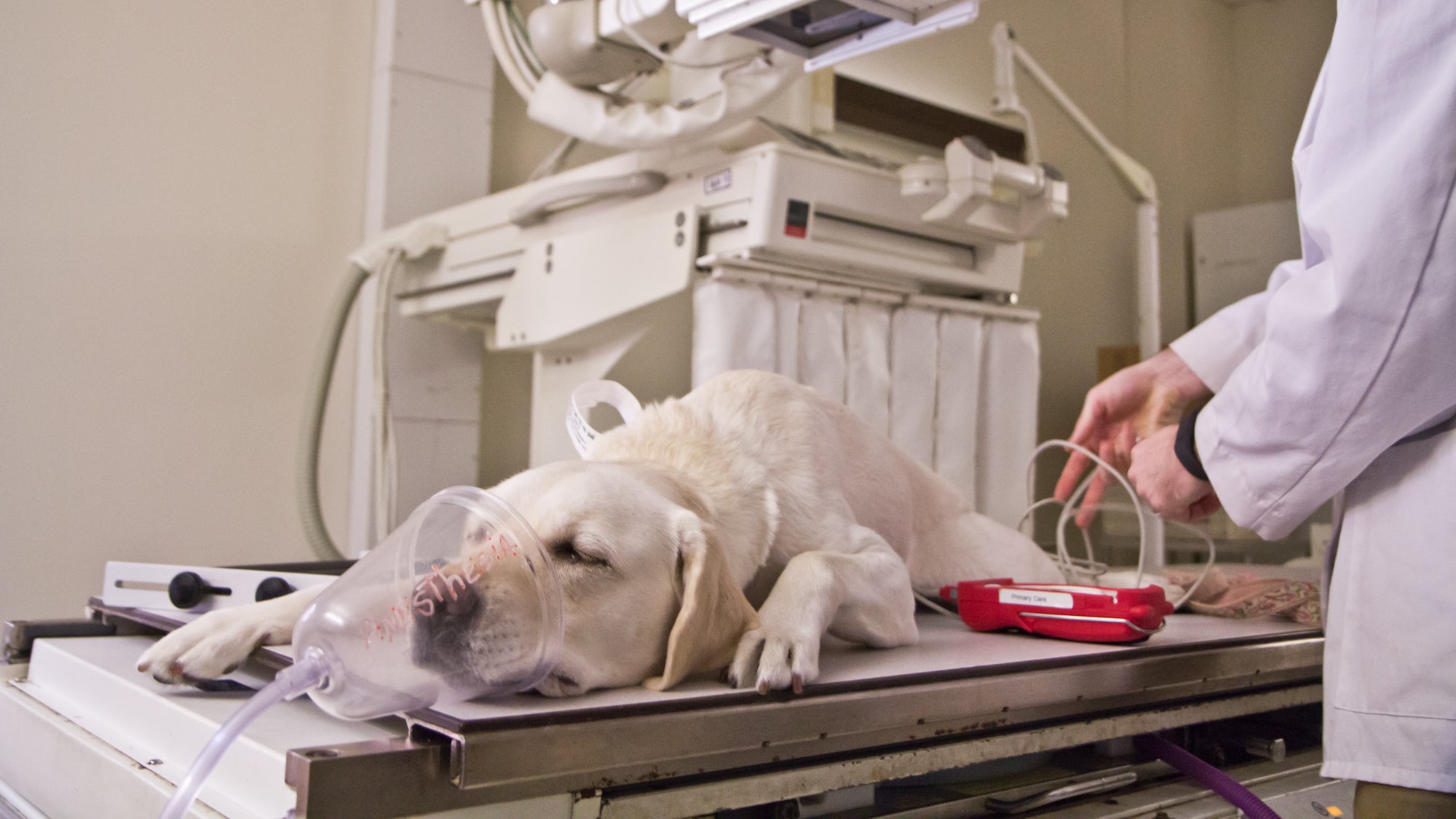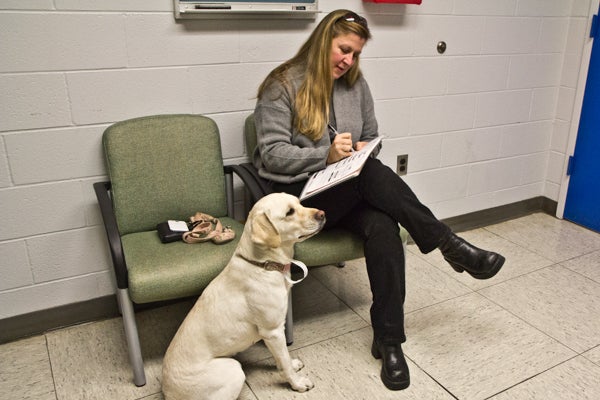Americans love designer dogs but health problems are common
Listen
Maven
Buyer beware: consider medical testing before getting a Cockapoo or Bullypit.
Dog breeding can create an intelligent silky-coated Golden Retriever, or a Pug whose short snout makes it hard for him to breathe. It’s hard to know exactly what you’ll get, so some breeders seek out genetic testing before creating the next generation.
In the hallway at the Veterinary Hospital at the University of Pennsylvania, anxious dogs bark and whine. But inside one exam room, it’s quiet.
Maven, a purebred yellow Labrador, sits patiently next to her pink leash. She’s light yellow–nearly white. Maven endured more than an hour of waiting and tests with a rotating cast of doctors, but the delay didn’t seem to bother her much.
The dog was calm. But her owner, Jen Rhyshek, was having a tense day.
“She’s my second generation in this line of Labradors. She’s a purebred and we’re hoping to get some good reports today because I would like to continue my breeding line with her,” Rhyshek said.
She knows nearly everything about her dog: the health of Maven’s parents, the last time Maven went into heat, and the particulars of the Lab’s unusual diet which includes mackerel, sardines, anchovy and salmon.
Maven has won awards in agility competitions and doesn’t look like she has any health problems, but Labradors often deal with eye problems that can cause blindness or hip issues that can lead to arthritis.
“Everyone’s trying to breed the perfect dog, that’s impossible,” Rhyshek said.
“So now you just have to breed the closest specimen to that. So it will absolutely depend on what results I get, whether I would decide to continue to breed. If I get bad news, absolutely not, it would be irresponsible to turn around and breed a dog that I know has a genetic defect.”
Pugs and other flat-nosed breeds commonly suffer from breathing problems, and Golden Retrievers may suffer from cataracts and heart disease. Those ‘purebred’ problems can be painful and costly.
So, Rhyshek paid for health screening—an eye exam and elbow X-rays.
In the dog world, there’s a real battle between many owners of purebred dogs and the mixed-breed owners.
For people who want a mixed breed “designer dog” the possibilities are endless: from little Puggles and Yorkipoos to bigger Pomskys and Goldendoodles.
Owner Jen Rhyshek says she would never mate Maven with a Poodle to create one of those intentionally mixed-breed dogs.

Owner Jen Rhyshek completes paperwork for x-rays and other testing to be conducted on her purebred yellow Labrador at at the Veterinary Hospital at the University of Pennsylvania. (Kimberly Paynter/WHYY)
Designer dogs
But Wally Conron did. He was the first to “design” a Labradoodle.
“From then on, my life became hell,” said Conron, who’s now a retiree living near Melbourne, Australia.
“People wanted to insult me no matter where I went because the Labradoodle had become so popular, that nobody wanted a purebred. And the purebred breeders, they were all ganging up.”
Conron had the best of intentions when he created the Labrador-Poodle mix in the 1980s.
The plan was to create a companion dog for a woman who had vision problems and her husband, who was allergic to dog hair. Labs are obedient. Poodles are less likely to trigger allergies.
“I realized sometime later that I’d created a Pandora’s box and created a Frankenstein monster,” Conron said.
Designer dogs can easily cost $1,000, and Conron says unscrupulous breeders started selling Labradoodles without proper testing or concern for the dog’s health.
“Cute as they may be, when you mix dog breeds, you really don’t know what you’re going to get,” said Margret Casal, an animal geneticist with the School of Veterinary Medicine at the University of Pennsylvania.
Her dog, Picasso, is a standard Poodle who rides sidecar on her motorcycle, and often comes to work with her.
Casal understands the uncertainty but didn’t mind getting mixed up in the complicated tangle of canine genetics. Picasso is a dad to a Goldendoodle, a Poodle and Golden Retriever mix.
Testing is essential to understanding what problems could occur in offspring, Casal said.
Genetic tests—which can cost anywhere from $75 to $300—can help breeders determine the likelihood of spinal cord disease or a defect in red blood cells that can lead to anemia and liver failure.
Maven, the yellow Lab, was evaluated for hip problems. Her screening cost about $600 and included X-rays.
Casal said it should be the cost of doing business for breeders.
“The one breeder that I know well, if there’s anything wrong in any of the offspring, the parents do not get bred anymore,” Casal said.
“But then there is, unfortunately, a number of people who sell, they call them designer breeds, but there’s no genetic testing done, there’s no health screening done at all.”
Simply knowing a dog’s breed isn’t enough to rule out health problems, said Anita Oberbauer, chair of the Department of Animal Science at the University of California at Davis.
It’s important to look beyond just the dog type and examine the animal’s genes, she said.
“So I’ll give you the Labradoodle example,” she said.
“It’s a Lab and a Poodle crossed. A Labrador has the same likelihood of having epilepsy, hip dysplasia, Addison’s disease as a Poodle. So if the sire has the ‘disease liability genes’ for any of those conditions I just mentioned, and the mother has the liability genes for Addison’s, epilepsy, hip dysplasia, you breed them together and the offspring will have it.”
Oberbauer says her students often ask what kind of dog they should get. She tells them not to focus too much on the specific breed but instead to make sure the breeder runs health tests.
For Maven, the yellow Lab, and owner Jen Rhyshek, there was good news: the dog doesn’t have signs of retinal disease and she has a low risk for developing hip disease.
So, she’ll probably become a mom soon.
WHYY is your source for fact-based, in-depth journalism and information. As a nonprofit organization, we rely on financial support from readers like you. Please give today.



